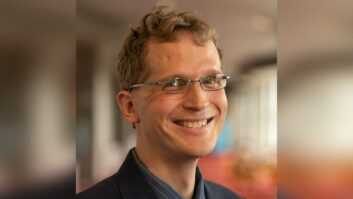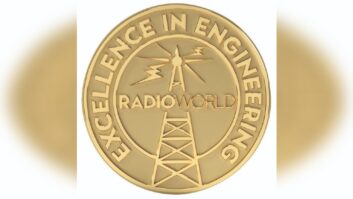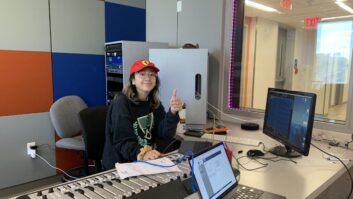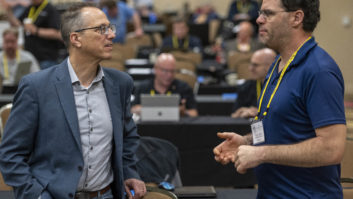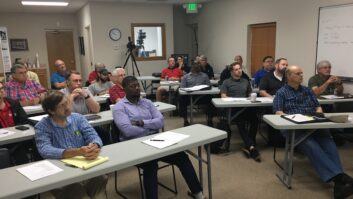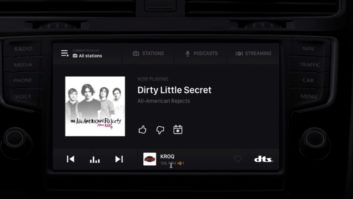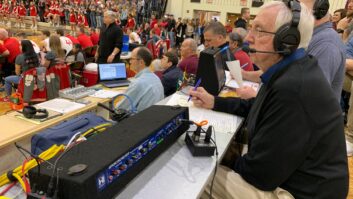Educational Media Foundation is one of the largest radio networks in the United States, with approximately 700 signals serving markets in nearly every state. With two contemporary Christian music formats, K-Love and Air1, it has grown from a single radio station in 1982 to a network serving a weekly cume of roughly 9 million listeners. The network comprises some 328 full-power radio stations and 340 FM translators. Though noncommercial, most of these stations are owned and operated by EMF.
Radio World Engineering Extra Technical Editor talked to Sam Wallington, the vice president of engineering for Educational Media Foundation. Wallington has an AS degree in electronics technology from Pacific Union College in California and began his career with an interest in sound systems. He has been with EMF for some 18 years, starting in 1993 as its only engineer. He now oversees a staff of 30 engineers, plus a team that specializes in new site construction.

How did you make your way into the radio broadcast industry?
Like most engineers, technical things have always been fun for me, starting as a toddler when I’d take things like a music box apart, figure out how it worked, play with it a bit and put it back together — so often that the fasteners wouldn’t hold any more. At 13, I became fascinated by the electronics involved in sound systems, and started volunteering at church under a very talented and creative elderly man, Barney LeDuc, who became my mentor. He encouraged me to continue to pursue interests in electronics and anything else mechanical, electrical or otherwise techie.
Just before I graduated from college, the campus radio station KCDS changed direction after some financial challenges and I somehow talked my way in the door as a volunteer and was able to help Bill Lyons, the chief engineer, finish wiring some new studios. Before I knew it — OK, it was seven months — my volunteering turned into a paying job.
A few years later, the victim of some budget cuts, I bounced from job to job before joining a friend to work as contract engineers in California’s North Bay Area. Educational Media Foundation became a client after a 1988 firestorm on Geyser Peak destroyed their only station’s transmitter site, then KCLB, and we helped in the emergency reconstruction of the station on a nearby mountain. That “emergency” mountain turned out to be the right place to be to begin feeding programming to other signals.
As contracting work dried up somewhat in the tight economy of 1993, I joined EMF as its sole staff engineer.
What kinds of duties do you have on a daily basis?
Originally, I was responsible for anything even vaguely technical … from facilities, such as toilets and air conditioners, to telephones and copiers, to studios and transmitters. As EMF has grown, my duties have changed, gradually splitting off various functions such as telecom, IT, studios, software development and physical plant.

C band uplink dish at the Indianapolis studios.
At this point, I am responsible for everything between the satellite uplink input and where it comes out of listener’s speakers. That means I primarily run an RF shop, though with obvious audio needs such as EAS and other emergency programming sources.
I lead an amazing team who can figure out a solution to just about any problem imaginable, usually under tight timelines and budget restrictions. Other than that, I get to help develop new technologies, such as the Wegener iPump store-forward audio system; train technical and operational staff; and help shape the future of the organization as a whole.
In a typical year, EMF builds, upgrades or makes significant changes at about 100 signals. By necessity, therefore, we have a site development group that manages these projects in cooperation with our engineers and acquisition/legal/application folks.
Due to changing circumstances, we frequently have to adjust our processes to compensate for new zoning and permitting laws, suddenly escalating rent rates, lack of access to power, or any number of other variables. In the “good old days” we could just put up an antenna on a tower most of the time. Now it’s appropriately necessary to confirm structural, zoning and other legal compliance in addition to the fun of building a transmitter facility. This is a constant source of entertainment.
What is your most interesting recent project?
One of the challenges we constantly face is the need to do everything several hundred times. For example, if a new box needs to go in at every signal, that means we’re installing about 700 boxes. Anything times 700 is expensive. Further, it’s essential that everything we buy or build is very stable, robust and reliable.
Recently, like many, we’ve just completed the rollout of the new Common Alert Protocol EAS. Honestly, the most challenging part was providing IP connectivity at all stations, since mountain-top IP isn’t always available, or anything resembling reliable.

Equipment racks at the Indianapolis uplink.
Fortunately, thanks to the foresight of one of my engineers, Alan Guthrie, we had been building an in-house satellite-based IP system for a couple years before CAP-EAS became required, so we were a long ways down the road. It turned out that what we originally envisioned as just a good way to gain secure remote visibility and access into our individual stations turned out to be a huge help in CAP-EAS.
Another project we’ve started has been the three-year rollout of the Worldcast Relio remote control system at all our stations. Worldcast developed this system in cooperation with Clear Channel, so we have been able to stand on the shoulders of others to gain knowledge of the amazing capabilities of this “smart” remote control system, and have had the fun of contributing some of our own ideas. For example, Alan Guthrie spec’ed a new I/O interface box that Worldcast was kind enough to have Sealevel build for us.
Like most stations, we’re constantly looking for ways to be more efficient. One of our blessings is an on-staff programmer, Paul Swagerty, who has developed software that helps us manage everything from where stuff is to signal routing through the network.
For example, he’s built software that allows our news team to instantly go on the air live at any facility or combination of facilities to air breaking news stories, all without engineering’s intervention in routing the signal. This is particularly useful at 3 a.m. It’s also relatively “bullet-proof” to avoid the unintended consequences of a typographical error causing the wrong commands to be sent to some or all stations.
Recently we completed construction on a backup network facility in Indianapolis with complete uplink capabilities. For some time, there was concern about our ability to continue to operate in the event of a catastrophic failure or disaster at our main uplink facility in Rocklin; this second location gives us the ability to continue to serve our audience even if we lose the main uplink completely, and provides the studios for our morning shows.

Alan Guthrie at KLRD’s solar-powered site in San Bernardino/Yucaipa, Calif.
How do you handle the national distribution of your program audio for K-Love and Air1?
EMF has used Ku-band satellite distribution since 1992, and in some cases such as translators, off-air feed from a regional signal. In 2002, we added Multiple Channel Per Carrier capabilities to allow flexibility in programming. Currently, we are building a C-band MCPC system to eliminate rain-fade issues, and expect to deploy the first downlink sites late this year. With the existing, fully-redundant Ku system, we are able to remotely switch any satellite receiver to another channel, which, as I mentioned, is handy for breaking news. But this capability also allows us to “cover” for some equipment failures in a way that’s transparent to the audience. Some facilities are “hardened” with backup generators, transmitters and/or auxiliary antennas. The depth of redundancy is typically based on the audience size of the station, market by market.
EMF seems to use a fair number of translators. What is your thinking about why to use them instead of fully power stations?
EMF has been utilizing translators since long before they became controversial, the first being constructed in the mid-’80s. They are an excellent tool to reach underserved areas, and since we are listener-supported, there has to be a clear community interest to justify constructing and operating these signals. Though we filed for a number of translators in the 2003 filing window, we constructed a very large percentage of the ones that were granted to us, the exceptions being those that were unbuildable due to circumstances beyond our control or were no longer considered necessary due to the passage of time and the addition of other EMF signals in an area.
We continue to operate those that have survived the inevitable encroachment of new or upgraded stations, with thousands of people benefitting from their presence every day.
What do you think of the proposed compromise that is pending at the FCC for the resolution of the frozen translator applications from 2003?
We do have more applications pending from that filing window, and our position on them is fairly evident in the various filings we’ve made since.
We are partially in support of, and partially opposed to, the FCC’s proposed compromise, and we’ve filed comments in the proceeding.

KLRI transmitter site, Idaho Falls/Rigby, Idaho.
As a bit of an aside, when the FCC was initially contemplating the LPFM service, I had hoped they would simply tweak the existing translator rules for LPFM operators, adding only the capability of local program origination when combined with the ownership and program-type requirements that are in the current LPFM rules. That would have maintained a relatively level playing field for these secondary services, avoiding many of the challenges faced today by both sides of the argument.
Does EMF have AM as well as FM stations?
We have a few AM stations. Because we mostly air music, and AM receiver quality has declined significantly since AM stereo “died,” we have found that listenership has been markedly less on AM. If the facility reasonably could be financially viable, we would consider it, but we do have lower listenership expectations from AMs. If we operated a talk format, we would probably feel differently, depending on the station, as many regional AMs have an enviable coverage area, especially at night. I share the frustration of many engineers, since AM can sound really good on well-made receivers.
How do you see the future of the radio industry?
There have been naysayers that have predicted complete and absolute doom for radio. According to one I remember from a few years back, we should be done by now.
Though radio faces unprecedented competition and distraction, content still remains king. Whether one operates a blog, a TV network, a radio station, or preaches in a small church, it is quality and innovative content that will bring — and keep — audience.

All in a day’s work: Wallington en route to antenna repair.
As an industry, radio has frequently done itself a disservice by placing the bottom line ahead of programming, which often translates as automation or syndicated programming without real concern for what the audience actually thinks or wants.
Unfortunately, some stations don’t really care what listeners think. For example, I know of a station where the program director regularly deletes the content of the listener comments answering machine — without ever listening to the comments.
If the listener’s opinion isn’t important enough to even hear, it’s not surprising that radio listenership is declining. Auditorium testing and ratings have their value, but only as part of a bigger equation. Bottom line and complaining aside, what are we as an industry doing to ensure that listeners actually want what we provide?
On the technical side, I think the industry is ready for some innovations. As the economy recovers, perhaps some have the creativity to come up with better ways of doing radio.
Is there a version of digital radio that would be markedly better than analog? Can we reduce the latency on HD Radio, especially on HD2 or HD3 channels?
What new ways can we find to improve reliability of all systems involved in generating a radio signal? How about transmitter or antenna designs that honestly improve overall efficiency, thereby cutting costs? What about technical ideas creating income innovation?
How could broadcasters, including TV, partner with telecommunication companies to relieve some of their download bandwidth squeeze? If we’re talking about putting a radio in a phone, why not use that radio to deliver IP content, freeing telco bandwidth and making money at the same time? As the original “streaming” providers, broadcasters should be good at it — it’s just sending bits instead of waves, right?
EMF isn’t perfect, but, like many broadcasters, intends to continue to improve. If we all do our part, the industry can have a bright future.





